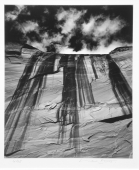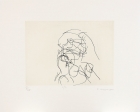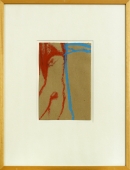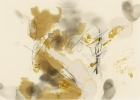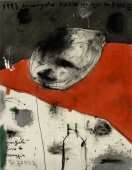
Artist | Beat Streuli (*1957)
https://www.artist-info.com/artist/Beat-Streuli
Biography
Biography
born in 1957
About the work (english / deutsch)
About the work (english / deutsch)
In General
What Beat Streuli does is the opposite of what a photo-reporter does. He shoots past the motif. In fact, his approach recalls the behaviour of the eleventh daughter of Reinhard Lettau: „If an object escapes her, it is possible that, with astonishment in her eyes, she mayfollow the path of her descending hand rather than that of the object itself, forgetting, like a bird, the incomprehensible intention of the flight, and savouring instead the act of flying." (Reinhard Kettau, Flucht vor Gästen; Munich, 1994, p. 63)
Photographing past the motif has less to do with intention, than with a certain attitude. Television, after all, has brought about the dissolution of the „interesting“ motif, drowning it in a flood of images that makes us forget the moment.
Beat Streuli swims upriver. He photographs what he finds as he swims against the tide. What is in flux is influenced more strongly by the current than by its own haecceity.
When I am on board a train or plane, I am being transported. My awareness of being transported is generally stronger than my perception of the people in my compartment. Beat Streuli does not swim upriver in order to swim against the tide. He does so quite simply because he stands still. By standing still, in the midst of people for example, one sees things one does not normally see.
Beat Streuli looks the way he would if he were not taking a photograph. To look at his photos is to see directly through the eyes of the observer rather than through the eyes of the photographer. Beat Streuli’s photographs bear witness, through photography, to the absence of photography. In other words, his is a backdoor approach that involves evasion of the image as a means of emphasizing it.
Beat Streuli photographs with the eye of an artist. He creates images by means of photography. There is a difference between enlarging a picture and conceiving it as a large image right from the start. As this is a question that crops up frequently, I would like to elucidate the issue by way of one simple example. When I pick up an exhibition catalogue or an art book and look at the illustrations, I try to envisage the size of the original works. The art history of this century has taught us just how difficult that is. There are paintings one can easily imagine being large and others one tends to think of as small. What is more, there are small paintings one wishes were large, because they have an inherent quality of such dimensional scope. In other words, there are images which are merely „blown up“, with little to justify their format, and images whose intrinsic dynamic force lends them a completely different dimension. Beat Streuli’s photographs are meant to be big. They are intended to give the spectator a 1:1 experience, emphasizing the synchronicity of seeing by highlighting the visuality of what is seen: that diffuse, unconscious, everyday vision concentrated briefly in moments of perception, remaining for a while as an afterimage, only to evaporate. This act of perception, however, refers only to that which triggers it. Beat Streuli’s achievement lies in capturing this act of perception within a structured environment and creating a highly distinctive image of an incidental occurrence. In Streuli’s large-format photos, image, space, depth, composition, grey tones and, in his more recent work, colour tones, are precisely balanced. Depending on one’s point of view, these can also be seen as abstract images: the combination of focused and unfocused, of visual corridor and foreground, of visual motion and physical motion along a diagonal axis or as structures of order and disorder in the case of construction materials and appliances. What hits us most in Beat Streuli’s images is the fact that they belong to us all. As Elias Canetti once put it, „Finding phrases so simple that they can no longer be one’s own." (Opus posthumum).
German text by Jean-Christophe Ammann / Translation by Ishbel Flett
(Extract - Full printed version available in the Museum)
MMK - Museum für Moderne Kunst, Frankfurt am Main
Allgemeines
Beat Streuli macht genau das Gegenteil dessen, was ein Reportagefotograf tut: Er fotografiert am Motiv vorbei. Er verhält sich wie die elfte Tochter von Reinhard Lettau, der von ihr sagt: „Entfällt ihr ein Gegenstand, so kann es geschehen, daß sie mit erstaunten Augen statt dieses Gegenstandes die zu ihm hinabtauchende Hand verfolgt, hierüber den Gegenstand selbst, zu dem sie doch unterwegs war, vergessend, so wie ein Vogel die übrigens nie ganz verständliche Absicht des Fluges vergißt und sich im Fliegen gefällt.“ (Reinhard Lettau, Flucht vor Gästen, München 1994, S. 63)
Am Motiv vorbei zu fotografieren hat nichts mit einer Absicht, sondern mit einer bestimmten Haltung zu tun. Letztlich hat das Fernsehen das „interessante“ Motiv aufgelöst. Ein Fluß von Bildern hat den Augenblick vergessen gemacht.
Beat Streuli schwimmt flußaufwärts. Er fotografiert was sich im Fluß befindet gegen den Strom. Was sich im Fluß befindet ist stärker durch das Fließen als durch seine Eigenart geprägt.
Wenn ich in der Eisenbahn oder im Flugzeug sitze, werde ich transportiert. Der Zustand des Transportiertwerdens ist grundsätzlich stärker als meine Wahrnehmung für die Menschen im Abteil. Beat Streuli schwimmt nicht flußaufwärts, um „gegen den Strom zu schwimmen“, sondern weil er einfach „stehen“ bleibt. Bleibt man stehen, etwa mitten unter den Menschen, sieht man Dinge, die man sonst nicht sieht. Beat Streuli schaut, als ob er eben gerade nicht fotografieren würde.
Betrachtet man seine Fotos, sieht man unvermittelt mit ihm, der schaut, aber nicht fotografiert: Beat Streulis Fotografien bezeugen die Abwesenheit der Fotografie durch die Fotografie. Anders ausgedrückt: Er geht vom Bild weg und bestärkt dieses durch die Hintertür.
Beat Streuli fotografiert aus der Sicht des Künstlers. Er schafft Bilder mit Mitteln der Fotografie. Es besteht ein Unterschied, ob ich ein Bild vergrößere oder ob ich es von Anbeginn groß konzipiere. Da diese Frage regelmäßig auftaucht, möchte ich die Problemstellung an einem einfachen Beispiel erläutern. Man nehme einen Ausstellungskatalog oder ein Kunstbuch, schaue sich die Abbildungen an und versuche die Originalgröße der Bilder zu eruieren. Gerade die Kunstgeschichte dieses Jahrhunderts lehrt uns, wie schwierig ein solches Unterfangen ist. Es gibt Bilder, die man sich groß vorstellt und die es nicht sind, und solche, die tatsächlich groß sind und die man sich eher klein denkt. Vor allem gibt es Bilder, die man sich groß wünscht, auch wenn sie es realiter nicht sind, weil sie das Potential des großen Ausmaßes in sich tragen. Mit anderen Worten: Es gibt Bilder; die „aufgeblasen“ ihr Format nicht halten können, und solche, denen aufgrund ihrer inneren Dynamik eine andere Dimension eigen ist.
Beat Streulis Fotografien sind groß konzipiert (gedacht). Sie sind darauf angelegt, dem Betrachter ein 1:1-Erlebnis zu vermitteln, ihm die Gegenwärtigkeit des Sehens als Bildhaftigkeit des Gesehenen nahe zu bringen. Gemeint ist das diffuse tägliche, unbewußte Sehen, das sich für kurze Momente in einem Wahrnehmungsakt konzentriert, als Nachbild hängen bleibt und sich wieder auflöst. Dieser Wahrnehmungsakt bezieht sich jedoch einzig auf das, was ihn auslöst. Die Leistung von Beat Streuli besteht darin, diesen Wahrnehmungsakt in ein strukturiertes Umfeld zu bannen und aus der Beiläufigkeit des Geschehens ein unverwechselbares Bild zu schaffen. In Streulis großformatigen Fotos halten sich Bild, Raum, Tiefe, Komposition, Grau- oder neuerdings auch Farbwerte genau die Waage. Je nach Standpunkt kann man die Bilder gewissermaßen auch abstrakt sehen: in der Verbindung von Schärfe und Unschärfe, von Blickkorridor und eingeschobenem Vordergrund, von Blick- und Gehbewegung in einer Diagonalachse oder als Ordnungs-Unordnungsgefüge im Falle von Baumaterialien und Gerätschaften.
Das Bewegende an den Bildern von Beat Streuli ist, daß sie uns allen gehören. Etwa so, wie Elias Canetti einmal sagte: „Sätze finden, so einfach, daß sie nie mehr die eigenen sind.“ (Opus postumum).
Text von Jean-Christophe Ammann
(Auszug - Der vollständige Text ist als Informationsblatt beim Museum erhältlich)
MMK - Museum für Moderne Kunst, Frankfurt am Main
 offers / Requests offers / Requests  |
About this service |
|---|
 Exhibition Announcements Exhibition Announcements  |
About this service |
|---|
 Visualization |
Learn more about this service | ||
|---|---|---|---|

Interested in discovering more of this artist's networks?
3 easy steps: Register, buy a package for a visualization, select the artist.
See examples how visualization looks like for an artist, a curator, or an exhibition place: Gallery, museum, non-profit place, or collector.

Exhibition History

|
SUMMARY based on artist-info records. More details and Visualizing Art Networks on demand. Venue types: Gallery / Museum / Non-Profit / Collector |
||||||||||||
| Exhibitions in artist-info | 112 (S 37/ G 75) |
Did show together with - Top 5 of 858 artists (no. of shows) - all shows - Top 100
|
||||||||||
| Exhibitions by type | 112: 44 / 36 / 30 / 2 | |||||||||||
| Venues by type | 84: 30 / 23 / 29 / 2 | |||||||||||
| Curators | 32 | |||||||||||
| artist-info records | Oct 1991 - Jul 2018 | |||||||||||
|
Countries - Top 5 of 18 Germany (40) Switzerland (13) United States (10) United Kingdom (8) France (7) |
Cities - Top 5 of 54 Frankfurt am Main (13) New York (10) Paris (7) Berlin (7) Zürich (6) |
Venues (no. of shows )
Top 5 of 84
|
||||||||||
Curators (no. of shows)
Top 5 of 32
|
| Tower - MMK | G | Mar 2018 - Jul 2018 | Frankfurt am Main | (10) | +0 | |
| Musée de l'abbaye Sainte-Croix | G | Oct 2016 - Jan 2017 | Les Sables d'Olonne | (27) | +0 | |
| Kunstmuseum Kloster Unser Lieben Frauen | G | May 2015 - May 2016 | Magdeburg | (78) | +0 | |
| Art Collection Deutsche Börse - Artists | S | Apr 2015 - Apr 2015 | Eschborn | (2) | +0 | |
| Kunstmuseum Wolfsburg | G | Mar 2014 - Oct 2014 | Wolfsburg | (71) | +0 | |
| Espai d'art contemporani de Castelló | S | Jan 2013 - Apr 2013 | Castelló | (46) | +0 | |
| Keep reading |















